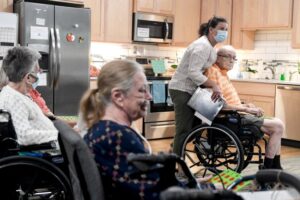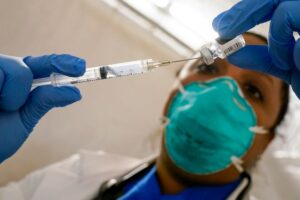As Colorado school districts roll out their COVID-19 guidance for the first fully in-person K-12 school year since 2019, the question of what role masks should play in the classroom as coronavirus continues to spread in the state is once again taking center stage.
Last week, hundreds rallied in front of the Jefferson County Public Health headquarters to denounce a mask mandate recently issued by Jeffco Public Schools for students 11 and younger — an age group still not eligible to receive a vaccine. Parents, many with children in tow, held signs reading “Unmask our Children” and “Masking Kids is Child Abuse,” while chanting a phrase long associated with the abortion rights movement, “my body, my choice.”
“It should be my choice,” said Brittney Buck, the mother of a first-grader at Kendallvue Elementary in Morrison. “I want her to be able to breathe the air, see smiles and socialize with others.”
But Dr. Dawn Comstock, executive director of Jefferson County Public Health, said with surging infections due to the highly contagious delta strain of the virus, masks in school are crucial to slowing the spread of a disease that has claimed more than 7,200 lives in Colorado over the last 17 months.
“The delta variant has changed the coronavirus landscape,” Comstock said. “A lot of the kids under 12 who can’t get vaccinated are at very high risk.”
Denver metro school districts are taking different approaches to masks for the upcoming year, perhaps a reflection of the politics and high emotion that have permeated the discussion around face coverings.
While Jefferson County Schools took a middle-of-the-road path with its decision to only require masks for part of its 84,000-student population, other districts forged their own paths. In neighboring Douglas County Public Schools, some of which are starting back up this week, district leaders are leaving the decision up to the student and/or parent, as well as teachers and staff, though masks are suggested for the unvaccinated.
In Jefferson County, the coronavirus is moving more quickly at the moment than it had been, Comstock said, leaping from 110.1 per 100,000 people in June to 214.9 per 100,000 in July. Among Jefferson County children younger than 12, the case rate has more than doubled from June to July.
Across the state, the Colorado Department of Public Health and Environment reported 5,583 new cases in the state in the week ending Aug. 1, the highest total since mid-May.
Comstock also pointed to recent reports out of Florida, Louisiana and Arkansas, where there’s been a significant spike in the number of pediatric hospitalizations for COVID-19. Still, according to a July 29 report from the American Academy of Pediatrics, severe illness and death from COVID-19 remains “uncommon in children.”
Both the U.S. Centers for Disease Control and Prevention and the American Academy of Pediatrics now recommend all students and staff wear masks in school. Face coverings, Comstock said, are far less disruptive to education than imposing quarantines, closing schools and reverting to remote learning.
“The primary goal of wearing masks is to emphasize, prioritize and protect in-person learning for our children,” Comstock said.
Hyoung Chang, The Denver Post
Third-grade students wait in line to enter Second Creek Elementary School in Commerce City on Sept. 3, 2020.
Kids largely spared by COVID
There’s no consensus about masks in schools among the state’s largest school districts.
Denver Public Schools last week announced that masks would be mandatory for all students and staff across the 90,000-student district. Westminster Public Schools is taking the same approach.
But, like Douglas County, other metro area districts Cherry Creek, Aurora and Littleton are not requiring masks, though they recommend or strongly recommend their use, especially among the unvaccinated. Further afield, Mesa County Valley School District 51 in Grand Junction and Colorado Springs School District 11 are not mandating masks for students.
On the state’s athletic fields, the Colorado High School Activities Association announced late last month that “local leaders will determine public health protocols for in-person learning and activity participation,” leaving some school districts and local health agencies flat-footed.
One of the common themes among school districts embracing voluntary-mask policies is respect for parental wishes. Littleton Public Schools in a letter to the community, for example, said it will “rely on parents to make the very best decision for their children.”
That’s how it should be, said Beth Parker, who three weeks ago moved her family from Golden to Douglas County, where COVID-19 restrictions are less severe. She was among the Jeffco crowd protesting in Lakewood on Wednesday.
“We think that parents know their kids best and should have the choice of how their kids attend school,” she said.
Mask opponents point to what has been the case for much of the pandemic: The virus doesn’t impact children with near the severity it does the elderly and the sick. In guidance posted online last week by the Cleveland Clinic, pediatric infectious disease specialist Dr. Camille Sabella wrote that children infected with the virus “generally speaking … have very mild symptoms if they have any at all.”
“So far, it does not appear that the delta strain has caused more severe illness in children even though it’s highly transmittable and much more contagious,” Sabella wrote.
Colorado health data bear that out, with fewer than 3.5% of all COVID hospitalizations in Colorado occurring among those 19 and younger. Just one quarter of 1% of all COVID deaths have been among that same cohort, according to the CDPHE COVID-19 tracking page.
Layer on the fact that 75% of eligible Jefferson County residents have received at least one vaccine shot, while more than 50,000 people in the county have acquired some level of natural immunity to the virus via infection.
It has some parents in Jeffco Public Schools left to wonder who the mask order is designed to protect.
“There is something inherently wrong with a society that asks kids to protect adults — adults have the choice to get vaccinated,” Parker said.
But the real problem, Comstock said, is parents who dismiss other parents’ concerns about their kids getting sick in school amid a surge in COVID-19 cases.
“They’re demanding the district make a decision that intentionally and unnecessarily places another parent’s child at risk,” she said. “That’s pretty remarkable. We should be doing everything we can to reduce all unnecessary risk.”
Denver did that just last week, when Mayor Michael Hancock ordered that all 10,000 people who work for the city and county, including public and private school teachers and staff, get vaccinated by Sept. 30. The order came a day before DPS handed down its mask mandate.
Kristen Seidel, a parent of two boys who attend DPS schools, said she doesn’t understand the pushback on masks.
“This is how we keep our schools open,” she said. “And masks are one of the best ways to do that until everyone can be vaccinated. Going back to remote learning is more detrimental than wearing masks for a few months.”

RJ Sangosti, The Denver Post
People gather for an anti-masking rally outside Jefferson County Public Health headquarters in Lakewood on Aug. 4, 2021.
“Not a permanent solution”
But masks are not without their problems, say those who oppose face coverings. Aside from being uncomfortable and potentially restricting breathing, masks degrade kids’ ability to learn and thrive, said Charity Rutan, a Lakewood mother who attended last week’s anti-mask rally.
“Kids are not getting the healthy social cues from their teachers and peers” when their faces are obscured, she said.
That phenomenon was analyzed at length by Dr. Manfred Spitzer, chair of the psychiatry department at the University of Ulm in Germany. He wrote a scholarly article for the journal Trends in Neuroscience and Education in September 2020 that concluded that a mask “reduces the ability to communicate, interpret, and mimic the expressions of those with whom we interact.”
“Positive emotions become less recognizable, and negative emotions are amplified,” he wrote. “In sum, recognition of, and response to, the outward emotional displays of one’s peers’ faces is a critical and necessary component of social interaction in schools.”
DPS board of education member Tay Anderson, a proponent of masks who is featured wearing one in the photo on his official Twitter account, acknowledged covering one’s face is not conducive to an optimal learning environment.
But he said it’s more important to first bring COVID-19 case numbers down before tossing masks aside.
“This is not a permanent solution,” Anderson said. “DPS is not saying we mask forever.”



















